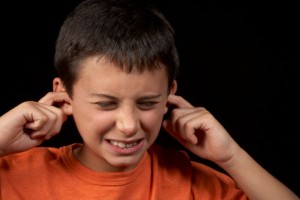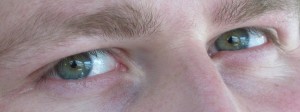More than meets the eye
In the course of spending hundreds of hours learning how bodies work and how we communicate with physical (non-verbal) language, I have learned a great deal about eye contact. And what I have learned contradicts virtually everything that I always understood about eye contact.
I have written previously about projection and attribution, our tendency to look at another person’s behavior and then “map” meaning onto that behavior. One can spend a lifetime understanding, and working with, projection and attribution, but let’s review the whole concept with a very simple little example.
Suppose we pass someone on the way into work, someone we know well enough that we expect them to look up and say hello. Instead, the person looks down at the ground and walks right past us. Most people will make up a story in their mind about why that happened. We make guesses about the reasons other people act the way they do. And the kinds of reasons we make up tend to have to do not with what’s going on inside the other person, but rather, within us.
If, on a very subtle level, we don’t like the person (but we’re not aware that we dislike them, or we’re not comfortable feeling it) then we’ll project that onto them: “the reason they didn’t look up is that they don’t like me.” Another way this can work is we ask, “well, if I was walking in the door and I intentionally looked down instead of saying hello to someone else, what would that mean for me?” If the answer is, “I’m uncomfortable with the other person” or “I’m angry about what happened in the meeting last week,” then that gets projected out.
The truth is, there’s really no way to know why the other person did that. (Actual reasons could include that they were suffering from diarrhea and focusing with great intent on making it to the restroom; or they found out a half hour before arriving at work that they were being sued for divorce by a spouse, or they suddenly remember something they had to work out in their head before a 9 AM meeting. There are endless reasons, and we almost never “guess” correctly what is motivating someone else’s behavior.) That doesn’t stop us from trying, however, and so the dance of projection and attribution can occupy a large space in our life, as we look at other peoples’ behavior and ask, almost always with futility, “what does it mean? What does it signal?” Becoming aware of how (and how much) we project and attribute is practically a full time job. It’s a big piece of waking up and getting clear.
 Eye contact is a huge playground for projection, and so there’s all kinds of folklore out there like “if someone is honest they’ll look you in the eyes” or “in order to form an intimate connection with someone, you need to sustain eye contact with them.” Not really. Not always. Not for all people. Those myths are examples of projections which are both cultural and personal.
Eye contact is a huge playground for projection, and so there’s all kinds of folklore out there like “if someone is honest they’ll look you in the eyes” or “in order to form an intimate connection with someone, you need to sustain eye contact with them.” Not really. Not always. Not for all people. Those myths are examples of projections which are both cultural and personal.
American kids are taught to look adult authorities in the eye when being spoken to. It is considered a sign of respect. Japanese kids are taught not to maintain direct eye contact but to look away approximately two thirds of the time, or to focus the eyes on the throat of the person speaking. This (the exact opposite of American behavior) is also considered a sign of respect. In many native American cultures, maintaining direct eye contact with an elder is seen as an act of contempt, the way two pack mammals would maintain eye lock just before attacking each other. Eye contact in American culture is a sign of obedience; in other cultures it can be a form of challenge. And lest we get black and white about it, there are many shades of gray in between.
For people on the autism spectrum, including people with extremely mild forms of autism including Asperger’s Syndrome, eye contact can be searing. Looking at faces places a high load on our mental processing facilities. Because of the amount of sensory information already coming into the autistic brain and the relative lack of filtering systems for sensory input, sustaining eye contact can be far from comforting and supportive. Quite the contrary: it can be invasive, overwhelming, and a form of unwelcome penetration.
If I were to share one bit of advice about eye contact gleaned from hundreds of Touch Practices, it would be, simply, “stop making such a big deal out of eye contact. Lighten up. Be more flexible about this whole thing.”
 I’ve been part of corporate trainings, church workshops and other facilitated group activities where a leader might, in the first hour of the workshop, do a variety of warm-up, icebreaking kinds of activities. Surprisingly often, someone thinks it’s a good idea to have people take turns, forming pairs, holding eye contact for a set amount of time. It’s a phenomenally terrible idea. If you use this technique, please don’t.
I’ve been part of corporate trainings, church workshops and other facilitated group activities where a leader might, in the first hour of the workshop, do a variety of warm-up, icebreaking kinds of activities. Surprisingly often, someone thinks it’s a good idea to have people take turns, forming pairs, holding eye contact for a set amount of time. It’s a phenomenally terrible idea. If you use this technique, please don’t.
And if you are tempted to reply, “well, it can be a challenge for some but it’s good for them,” consider another exercise: men and women, pair off, and men, spend thirty seconds staring at the breasts of the person in front of you as a “warm-up” before trading off with the next person. Some of you will find this challenging, but it will help you get to know each other.” You like that exercise as much?
Really. If we’re awake we recognize the right of other people to decide when, how and whom they let in to their bodies. If indeed the eyes are the ‘window of the soul,’ it’s one of the important ways into the body. The only person making the decision as to when, how often and how far to open that window should be the person inside the body. Many people fail to realize that for some, engaging in prolonged eye contact with a stranger is an unreasonably invasive and penetrating experience, and not one that invites comfort or security.
In Touch Practice, eye contact is variable, completely optional, and totally within the control of the partner. I have done 90 minute practices where our eyes may have been open for a total of only 4 or 5 minutes, usually only when we are transitioning to a new position or have good reason to look for or at each other. Sometimes in the middle of a practice, after a half-hour of sitting with our eyes closed or without having made eye contact, suddenly there will be a moment of eye contact where we both break out into big grins, as though we have seen each other for the first time, or recognize each other. It can take a half hour of prolonged physical contact for someone to feel connected enough to sustain eye contact. When it occurs spontaneously, it’s a beautiful, intimate thing. When it’s imposed by someone else, it’s a form of unwelcome penetration.
Touch Practice can proceed almost entirely without visual information. Two people can form a remarkably intimate bond with each other almost without looking at all. If I’m in physical contact with another body, I get way more information from the pattern and pace of breathing, posture and muscle tone than I would ever get from visual assessment. In fact, sometimes I close my eyes to help me avoid projecting. Things are not always what they look like.
 Explore your awareness of how we use eye contact and what we project onto it. If I make intentional eye contact with passers-by in the course of a 15 minute walk; one of them thinks I’m friendly; the next thinks I’m horny; the third thinks I’m homophobic; the fourth thinks I’m going to ask her for directions; the fifth feels like I’m challenging his right-of-way, and the list goes on and on.
Explore your awareness of how we use eye contact and what we project onto it. If I make intentional eye contact with passers-by in the course of a 15 minute walk; one of them thinks I’m friendly; the next thinks I’m horny; the third thinks I’m homophobic; the fourth thinks I’m going to ask her for directions; the fifth feels like I’m challenging his right-of-way, and the list goes on and on.
Eye contact means, literally, nothing, or everything, or something in between. It means what we make it mean, and we each make it mean something entirely different, depending on our culture, our mood, and our experience. I invite you to an exercise of awareness about your projections, assumptions and attributions, and I invite you to suspend your insistences, your demands, around eye contact. We all have very different bodies, very different needs in terms of how we touch each other and are touched by others. And, while it may sound strange, looking at each other is one of the deepest ways in which we touch.
Have a great week, and thanks, as always, for considering these oddball ideas I put out there every week!
Have thoughts you’d like to share?
Touch Practice is a sacred practice for me, and part of that is keeping confidences sacred. While a name and e-mail address are required to post a comment, feel free to use just your first name, or a pseudonym if you wish. Your e-mail address will never be seen by or shared with anyone. It is used to prevent spam and inappropriate comments from appearing in the blog. I’d really like to hear from you!














Thank you so much for this post! I loathe those “get to know you” exercises. I have some odd perceptual issue where if I am standing too close to something, I can’t “see” it. It’s a huge problem in stores if the aisles are narrow, because I can’t make sense of the items on the shelves if I can’t get far enough away from them so that I can “see” them. It’s a similar problem with these eye contact exercises, and it’s complicated in that I can’t look at the other person’s 2 eyes: I can only focus on one, and then I have to shift to the other, and then back to the first. I feel incredibly awkward in those exercises, and they do more to have me shut off a part of myself than to be open and welcoming. Thank you very much for your posts.
Ted, I’m really glad you wrote to tell us about your experience. This is something it has taken me a long time to learn about, because in general I’m a person who is very comfortable making eye contact with people. I’ve had to learn that it isn’t always “loving” for me to stare deeply into someone’s eyes in an attempt to convince them how wonderful I find them; on the contrary, I can succeed in making the person quite uncomfortable!
We’re all so different in that regard, and learning how to “hold” the differences of another, whether physically or in other ways, is what Touch Practice is about, for me. I’m grateful to hear from people like you, people who are all different from me in different ways, so that I can learn from all of you. Thanks again for sharing your story.